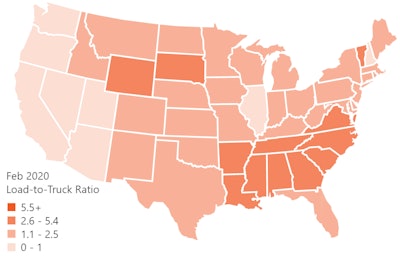With supply chains strained by the impact of the COVID-19 coronavirus, average rates shot higher for reefers and van, compared to the preceding week, during the week ending March 22, said DAT Solutions.
National average spot rates, March (through the 22nd)
**Van: $1.85 per mile, up 3 cents from last week and 6 cents higher than the February average
**Reefer: $2.16 per mile, up 5 cents from last week and 7 cents higher than February
**Flatbed: $2.20 per mile, unchanged from last week, up 5 cents compared to February
The average spot van rate increased on 88 of the 100 highest-volume lanes on DAT load boards compared to the previous week. The line-haul van rate (minus an average fuel surcharge), which entered the month a good deal below last year’s average, has jumped 12% since March 1 and is up 16 cents year over year:
**March 1: $1.51 per mile, compared to $1.58 a year ago
**March 23: $1.70 per mile, compared to $1.54 a year ago
Mid-range hauls are paying better
Any overnight stay for the driver involves safe parking, decent food and other roadside necessities that can be in short supply right now. Shippers are paying more for van capacity on “tweener” lanes with lengths of haul in the 250- to 600-mile range. Examples:
**Memphis to Chicago averaged $2.06 per mile, up 25 cents; Chicago to Memphis added 10 cents to $1.93
**Atlanta to Columbus, Ohio, averaged $1.78 per mile, up 19 cents; the return rose 8 cents to $2.06
**Columbus to Memphis averaged $1.75 per mile, up 14 cents; the return gained 8 cents to $2.16
**Dallas to Houston averaged $2.42 per mile, up 19 cents; the return rose 3 cents to $2.03
All around, replenishment is, of course, driving demand with a surge in volume, as reflected in load-to-truck ratios (LTRs) and rates.
 The national average van load-to-truck ratio last week was 3.5, up from 3.2 the previous week. That’s the eighth straight week of rising ratios. More dramatically, the average ratio has more than doubled (up 150%) since the same week in 2019. By separating the trends in load posts from the truck posts, we can see clearly that demand is the key factor driving the ratio higher.
The national average van load-to-truck ratio last week was 3.5, up from 3.2 the previous week. That’s the eighth straight week of rising ratios. More dramatically, the average ratio has more than doubled (up 150%) since the same week in 2019. By separating the trends in load posts from the truck posts, we can see clearly that demand is the key factor driving the ratio higher.More pressure coming
Large-scale shutdowns of schools, restaurants, and other food-service venues have focused shippers’ and carriers’ attention almost entirely on retail grocery outlets, including e-commerce. Further, reefers must be loaded “live” with perishable goods, making delays and disruptions even more costly. In the coming weeks, a new layer of demand will be added to the mix when spring produce harvests begin. Expect reefer rates to remain elevated from now through the end of June.








